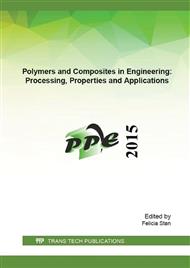[1]
R. Mohan, R. Sung Hun, A.M. Shanmugharaj, Thermal, mechanical and electroactive shape memory properties of polyurethane (PU)/poly (lactic acid) (PLA)/CNT nanocomposites, Eur. Polym. J. 49 (2013) 3492-3500.
DOI: 10.1016/j.eurpolymj.2013.08.009
Google Scholar
[2]
C. Schilde, M. Schlomann, A. Overbeck, S. Linke, A. Kwade, Thermal, mechanical and electrical properties of highly loaded CNT-epoxy composites – A model for the electric conductivity, Compos. Sci. Technol. 117 (2015) 183-190.
DOI: 10.1016/j.compscitech.2015.06.013
Google Scholar
[3]
F. Quadrini, D. Bellisario, L. Santo, Recycling of thermoset polyurethane foams, Polym. Eng. Sci. 53 (2013) 1357-1363.
DOI: 10.1002/pen.23393
Google Scholar
[4]
Z. Spitalskya, D. Tasisb, K. Papagelisb, C. Galiotis, Carbon nanotube–polymer composites: Chemistry, processing, mechanical and electrical properties, Prog. Polym. Sci. 35 (2010) 357-401.
DOI: 10.1016/j.progpolymsci.2009.09.003
Google Scholar
[5]
H. Jin-Hua, Z. Hui, C. Ming-Ji, W. Guo-Rui, Z. Zhong, CNT buckypaper/thermoplastic polyurethane composites with enhanced stiffness, strength and toughness, Compos. Sci. Technol. 103 (2014) 63-71.
DOI: 10.1016/j.compscitech.2014.08.015
Google Scholar
[6]
J.N. Coleman, U. Khan, W.J. Blau, Y.K. Gunko, Small but strong: a review of the mechanical properties of carbon nanotube–polymer composites, Carbon 44 (2006) 1624-1652.
DOI: 10.1016/j.carbon.2006.02.038
Google Scholar
[7]
D.J. Martin, A.F. Osman, Y. Andriani, G.A. Edwards, Thermoplastic polyurethane (TPU)-based polymer nanocomposites, Woodhead Publishing Limited, 2012, pp.321-350.
DOI: 10.1533/9780857096241.2.321
Google Scholar
[8]
http: /www. etrma. org, European tyre & Rubber Manufacturers Association, End of Life Tyres: a Valuable Resource with Growing Potential, (2011).
Google Scholar
[9]
W.C. Wang, C.J. Bai, C.T. Lin, S. Prakash, Alternative fuel produced from thermal pyrolysis of waste tires and its use in a DI diesel engine, Appl. Therm. Eng. 93 (2015) doi: 10. 1016/j. applthermaleng. 2015. 09. 056.
DOI: 10.1016/j.applthermaleng.2015.09.056
Google Scholar
[10]
M. Nachman, K. Kwiatkowski, The effect of thermal annealing on the abrasion resistance of a segmented block copolymer urethane elastomers, Wear 306 (2013) 113-118.
DOI: 10.1016/j.wear.2013.07.014
Google Scholar
[11]
Y. Yanagiharaa, N. Osaka, S. Iimori, S. Murayama, H. Saito, Relationship between modulus and structure of annealed thermoplastic polyurethane, Mater. Today Commun. 2 (2015) e9-e15.
DOI: 10.1016/j.mtcomm.2014.10.001
Google Scholar
[12]
C. Garzón, H. Palza, Electrical behavior of polypropylene composites melt mixed with carbon-based particles: Effect of the kind of particle and annealing process, Compos. Sci. Technol. 99 (2014) 117-123.
DOI: 10.1016/j.compscitech.2014.05.018
Google Scholar
[13]
Y. Zeng, P. Liu, J. Du, L. Zhao, P.M. Ajayan, H.M. Chengm, Increasing the electrical conductivity of carbon nanotube/polymer composites by using weak nanotube–polymer interactions, Carbon 48 (2010) 3551-3558.
DOI: 10.1016/j.carbon.2010.05.053
Google Scholar
[14]
F. Vila, P. Dhima, F. Mandija, The influence of temperature on the electrical resistivity of the cellular polypropylene and the effect of activation energy, SpringerPlus 2: 472 (2013) 2: 472.
DOI: 10.1186/2193-1801-2-472
Google Scholar
[15]
S. Wang, Characterization and analysis of electrical conductivity proprieties of nanotube composites-Thesis, Departament of Industrial Engeneering, The Florida State University, (2005).
Google Scholar
[16]
I.D. Rosca, S.V. Hoa, Highly conductive multiwall carbon nanotube and epoxy composites produced by three-roll milling, Carbon 47 (2009) 1958-(1968).
DOI: 10.1016/j.carbon.2009.03.039
Google Scholar
[17]
F. Grillard, C. Jaillet, C. Zakri, P. Miaudet, A. Derré, A. Korzhenko, P. Gaillard, P. Poulin, Conductivity and percolation of nanotube based polymer composites in extensional deformations, Polymer 53 (2012) 183-187.
DOI: 10.1016/j.polymer.2011.11.020
Google Scholar
[18]
C. Feng, L. Jiang (2013), Micromechanics modeling of the electrical conductivity of carbon nanotube (CNT)–polymer nanocomposites, Composites: Part A 47 (2013) 143-149.
DOI: 10.1016/j.compositesa.2012.12.008
Google Scholar
[19]
T. Takeda, Y. Shindo, Y. Kuronuma, F. Narita, Modeling and characterization of the electrical conductivity of carbon nanotube-based polymer composites, Polymer 52 (2011) 3852-3856.
DOI: 10.1016/j.polymer.2011.06.046
Google Scholar
[20]
E. Bilotti, H. Zhang, H. Deng, R. Zhang, Q. Fu, T. Peijs, Controlling the dynamic percolation of carbon nanotube based conductive polymer composites by addition of secondary nanofillers: The effect on electrical conductivity and tuneable sensing behaviour, Compos. Sci. Technol. 74 (2013).
DOI: 10.1016/j.compscitech.2012.10.008
Google Scholar
[21]
J. Bouchard, A. Cayla, E. Devaux, C. Campagne, Electrical and thermal conductivities of multiwalled carbon nanotubes-reinforced high performance polymer nanocomposites, Compos. Sci. Technol. 86 (2013) 177-184.
DOI: 10.1016/j.compscitech.2013.07.017
Google Scholar
[22]
M. Felisberto, A. Arias-Dura´n, J.A. Ramos, I. Mondragon, R. Candal, S. Goyanes, G. H. Rubiolo, Influence of filler alignment in the mechanical and electrical properties of carbon nanotubes/epoxy nanocomposites, Physica B. 407 (2012) 3181–3183.
DOI: 10.1016/j.physb.2011.12.059
Google Scholar
[23]
J. Chen, Z. Zhang, W. Huang, J. Li, J. Yang, Yong Wang, Zuo-wan Zhou, Ji-hong Zhang, Carbon nanotube network structure induced strain sensitivity and shape memory behavior changes of thermoplastic polyurethane, Mater. Des. 69 (2015) 105–113.
DOI: 10.1016/j.matdes.2014.12.054
Google Scholar
[24]
Information in www. nanocyl. com – Nanocyl, Technical Data Sheet.
Google Scholar
[25]
P. Theilmann, D.J. Yun, P. Asbeck, S.H. Park, Superior electromagnetic interference shielding and dielectric properties of carbon nanotube composites through the use of high aspect ratio CNTs and three-roll milling, Org. Electron. 14 (2013).
DOI: 10.1016/j.orgel.2013.02.029
Google Scholar
[26]
S. Kirkpatrick, Percolation and conduction, Rev. Mod. Phys. 45 (1973) 574-588.
DOI: 10.1103/revmodphys.45.574
Google Scholar
[27]
D. J. Bergman, D. Stroud, Physical properties of macroscopically inhomogeneous media, Solid State Phys. 46 (1992) 147-269.
DOI: 10.1016/s0081-1947(08)60398-7
Google Scholar


